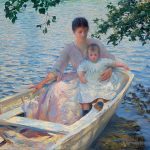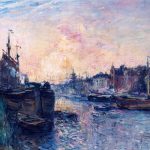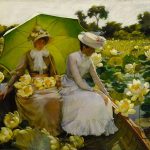Frederick Childe Hassam, an emblematic figure of American Impressionism, was born on October 17, 1859, in Dorchester, Boston, Massachusetts. His artistic journey, marked by the vibrant depiction of urban and coastal scenes, has left an indelible mark on the tapestry of American art, making Hassam one of the most esteemed painters of his era. This biography explores the life, work, and legacy of an artist who captured the ephemeral beauty of light and landscape, reflecting the dynamism of American life at the turn of the 20th century.
Hassam’s early exposure to art came from his surroundings in Boston, a city with a burgeoning cultural scene. Despite his family’s modest means—his father was a cutlery merchant—Hassam’s interest in art was encouraged. He left high school without graduating, opting instead to pursue artistic training. He began his career as an illustrator, working for local publishing firms, and took evening classes at the Lowell Institute, a division of the Massachusetts Institute of Technology, and the Boston Art Club. These formative years were crucial, providing Hassam with a foundational skill set that would influence his later works.
Paris and Impressionism
In 1886, Hassam traveled to Paris, the epicenter of the art world, to study at the prestigious Académie Julian. It was here that he encountered Impressionism, a movement that was to have a profound impact on his style. The emphasis on light and color, as well as the technique of capturing moments with quick, brushy strokes, resonated with Hassam. Though he absorbed these influences, his work remained distinctly his own, blending Impressionist techniques with a stronger form and composition.
Upon returning to the United States in 1889, Hassam settled in New York City. The bustling streets, public parks, and changing seasons offered endless inspiration. His series of paintings capturing the city’s avenues and flag-draped buildings are among his most famous works, celebrating both the energy of urban life and the patriotic fervor of the times. Hassam’s New York scenes, characterized by their lively brushwork and delicate use of light, helped introduce Impressionism to the American public.
Hassam was a prolific artist, producing over 3,000 paintings, watercolors, etchings, and lithographs throughout his career. He was particularly fascinated by the interplay of light and color, often depicting the same scene at different times of day or seasons to capture varying atmospheres. Unlike many of his contemporaries, Hassam did not seek to replicate European Impressionism but instead aimed to create a distinctly American version of the movement, focusing on local landscapes and urban scenes.
In 1897, Hassam became a founding member of The Ten American Painters, a group that sought to break away from the conservative American art establishments. Through their exhibitions, Hassam and his colleagues promoted Impressionism and other avant-garde movements, significantly influencing American art’s evolution. This group, also known as “The Ten,” was instrumental in fostering an environment that allowed for artistic innovation and independence.
Celebrating America
Hassam continued to paint prolifically until his death on August 27, 1935, in East Hampton, New York. His later works included a series of flag paintings that were both a response to World War I and a celebration of American resilience and spirit. These pieces are considered among his most significant contributions to American art, showcasing his mastery of light, color, and atmosphere.
Frederick Childe Hassam’s legacy is that of a pioneer of American Impressionism. His dedication to capturing the transient effects of light and atmosphere helped to define the movement in the United States. Today, his works are housed in the nation’s most prestigious museums, celebrated for their contribution to the narrative of American art. Hassam’s ability to convey the beauty of the American landscape and urban life with such vibrancy and immediacy has ensured his place among the foremost artists of his time.






